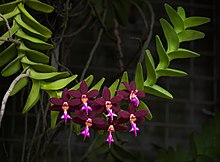| Dark purple trichoglottis | |
|---|---|

| |
| Trichoglottis atropurpurea, the Dark Purple Trichoglottis | |
| Scientific classification | |
| Kingdom: | Plantae |
| Clade: | Tracheophytes |
| Clade: | Angiosperms |
| Clade: | Monocots |
| Order: | Asparagales |
| Family: | Orchidaceae |
| Subfamily: | Epidendroideae |
| Genus: | Trichoglottis |
| Species: | T. atropurpurea
|
| Binomial name | |
| Trichoglottis atropurpurea | |

| |
| distribution of Trichoglottis atropurpurea | |
| Synonyms[2] | |
| |
Trichoglottis atropurpurea, the dark purple trichoglottis, is a species of orchid endemic to the Philippines.[2] This hot to warm growing epiphyte was first found growing in mangrove swamps in the islands of Biliran, Catanduanes, Mindanao (Agusan del Sur and Davao) and Polillo.[3] The plant shares the same appearance with T. philippinensis except for the rich dark color of the blooms and slight variation of the perianth.[4] This species was first described in 1877 by the German botanist Heinrich Gustav Reichenbach, an expert on the orchid family. At that time, thousands of newly discovered orchids were being sent back to Europe, and he was responsible for identifying, describing and classifying many of these new discoveries.[5]
- ^ "Trichoglottis atropurpurea". International Plant Names Index (IPNI). Royal Botanic Gardens, Kew; Harvard University Herbaria & Libraries; Australian National Botanic Gardens. Retrieved 10 December 2016.
- ^ a b "World Checklist of Selected Plant Families". Royal Botanic Gardens, Kew. Retrieved 2014-12-12.
- ^ Williams, Louis Otho (1938). "Philippine Trichoglottis". The Philippine Journal of Science. 65: 391. Retrieved 12 December 2014.
- ^ Ames, Oakes (April 5, 1922). Orchidaceae: illustrations and studies of the family Orchidaceae (7 ed.). Ames Botanical Laboratory, North Easton, Massachusetts: The Merry Mount Press. p. 136. Retrieved 10 December 2016.
- ^ Reinikka, M. A. A History of the Orchid, p. 215, Timber Press, Oregon, 1995